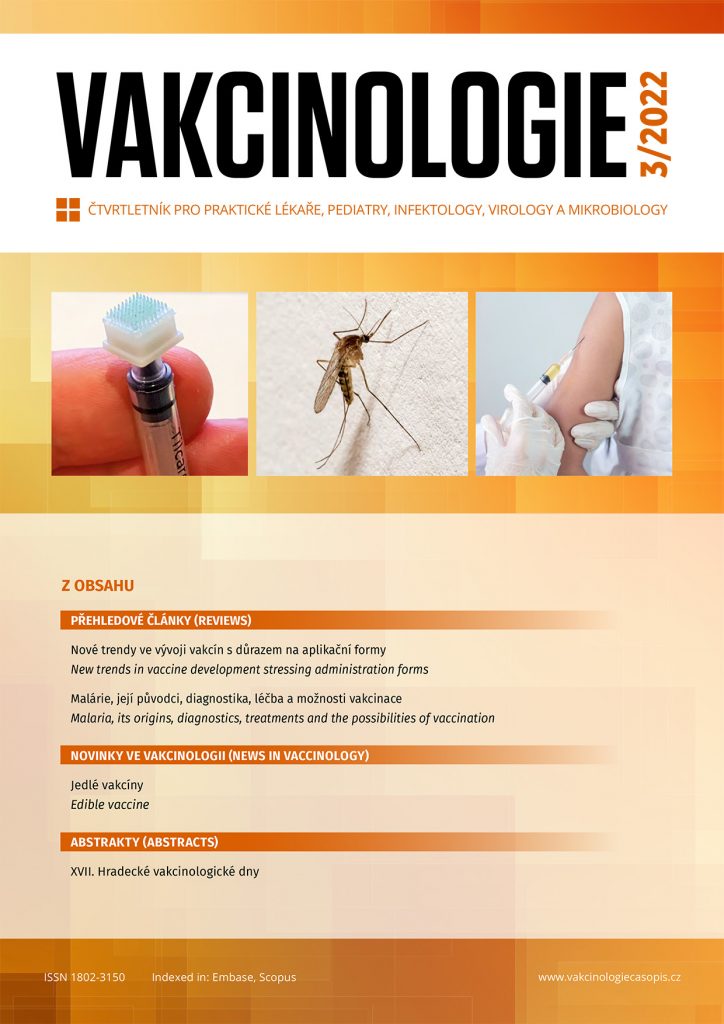Content:
- Editorial
- New trends in vaccine development stressing administration forms – Roman Prymula, Lenka Teska Arnoštová
- Malaria, its origins, diagnostics, treatments and the possibilities of vaccination – Petr Šíma, Vanda Boštíková, Lucie Siráková
- Edible vaccine – Hana Střítecká
Editorial
Vážení čtenáři, kolegové a kolegyně,
během času adventního by se chtělo oprostit od problémů každodenního života a v klidu spočinout v klidu v kruhu rodinném. Bohužel i v prosinci bylo nutné řešit řadu palčivých otázek. Ukazuje se, že covid-19 zanechal nejen obrovské škody ve společnosti, ale ovlivnil i náš imunitní systém. Nejedná se pouze o samotný SARS-CoV-2, ale dopady měla opatření také na ostatní infekční onemocnění. Izolační opatření ovlivnila například i výskyt chřipky a RS virových infekcí.
V současné době vnímáme poměrně masívní výskyt zejména RS virů. Příkladem je Německo, kde v minulých týdnech probíhala a stále probíhá velká epidemie, postihující z logiky věci zejména nejmladší ročníky v populaci. Došlo dokonce téměř k vyčerpání kapacity dětských lůžek, kdy 43 dětských nemocnic nemělo ani jedno volné lůžko, docházelo k sekundárním převozům a jistě byla ovlivněna kvalita péče. RS viry jsme viděli v České republice, ale i v jiných zemích Evropy už v loňském roce, kdy průběh onemocnění byl poměrně těžký, trvající až 14 dnů. Jistě je to dáno imunitním stavem populace, kdy vidíme několikaleté vlny v závislosti na odstupu od předcházející epidemie. To nejsme zcela schopni ovlivnit.
Co ale ovlivnit schopni jsme, je otázka proočkovanosti proti chřipce. Jsme na prahu chřipkové sezóny, kdy na základě zkušeností od protinožců očekáváme horší sezónu ve srovnání s posledními lety. Paradoxně však zjišťujeme, že nákupy vakcíny i její využití zatím klesly přibližně o dvacet procent. To jistě není dobrou vizitkou a jeden z hlavních problémů je riziko nákladů s nevyočkovanými dávkami, které leží na bedrech praktických lékařů, a ne na bedrech státu či pojišťovny. Proto v řadě případů velmi rezervovaný přístup praktických lékařů nevede k zvyšování proočkovanosti.
Snad se nám podařilo během vánočních svátků zregenerovat síly, neboť nás nečeká zcela jednoduchý rok.
S přáním všeho dobrého, a hlavně duševního i fyzického zdraví
prof. MUDr. Roman Prymula, CSc., Ph.D.
[články]
New trends in vaccine development stressing administration forms
Summary:
Routes of vaccine administration are currently undergoing rapid development. Classic intramuscular or subcutaneous vaccinations are no longer the only ones. Recently, in particular permucosal and transdermal, inhalation and oral forms of administration have been tested. These enable a significantly safer administration route, which in many cases does not require administration by a trained person or strict adherence to the cold chain. In developing countries with tropical temperatures, the use of vaccines applied in the form of a transdermal patch is significantly easier, and the possible storage at room temperature leads to huge savings in their administration. The new routes are a promise for the rationalization of vaccination in the future, but also a positive argument in the recently intensified fight with anti-vax groups. The new administration forms also do not need such high antigen contents as vaccines that are administered intramuscularly and, if necessary, allow significantly speeding up production.
Keywords:
vaccination, routes of administration, vaccine delivery systems, intramuscular administration, cold chain, vaccine hesitancy
Roman Prymula,1,2 Lenka Teska Arnoštová3
1Ústav preventivního lékařství, Lékařská fakulta Univerzity Karlovy, Hradec Králové
2Nemocnice Agel Říčany
3Centrum zdravotnického práva, Právnická fakulta Univerzity Karlovy, Praha
Malaria, its origins, diagnostics, treatments and the possibilities of vaccination
Summary:
Malaria is a tropical parasitic disease transmitted by mosquitoes mainly of genus Anopheles. The causative agents are various species of parasitic protozoans of the genus Plasmodium. P. vivax is responsible for approximately 80% of the world’s infections. P. falciparum causes about 15% of infections each year, whereas 5% infections are caused by P. ovale or P. malariae. Plasmodia multiply in red blood cells, which eventually disintegrate. The process accompanies typical clinical symptoms as a high fever, rigor, and chills. Around 100 countries, home to 2 billion people, are endemic for malaria. Until a few years ago, around 500 million people fell ill each year and up to 2 million succumbed. According to the latest World Health Organization data (World Malaria Report 2021), 241 million people became ill with malaria in 2020, of which 670,000 died. In tropical Africa, more than 90% of deaths cause mainly P. falciparum. In addition to sub-Saharan Africa, India, Southeast Asia, the Amazon region of South America and some islands in the Western Pacific are most affected. According to WHO, malaria has been eradicated in 39 countries, including China, but even here the so-called airport form of malaria caused by the importation of people traveling from endemic areas remains a serious problem. The development of vaccines, which appear to be the most effective tool in the fight against an insidious disease, takes many decades. In 2021, the WHO approved the first antimalarial vaccine, RTS,S/AS01, for use in children living in the most affected areas of Africa.
Keywords:
malaria, mosquitoes, plasmodium, parasitic protozoa, diagnostics, vaccination, vaccine, antimalarial drugs
Petr Šíma,1 Vanda Boštíková,2 Lucie Siráková2
1Laboratoř imunoterapie, Mikrobiologický ústav AV ČR, Praha
2Katedra epidemiologie, Fakulta vojenského zdravotnictví, Univerzita obrany, Hradec Králové
Edible vaccine
Summary:
The idea of oral immunization – with an edible vaccine – could be a major alternative to conventional vaccines. Because it consists only of antigenic protein and does not contain pathogenic genes, it has no way to create an infection and is safe in this respect. Edible vaccines play an important role in stimulating mucosal immunity because they come into contact with the lining of the digestive tract. They are safe, affordable, have low production costs and therefore could help in prevention and health care in developing countries.
Keywords:
edible vaccine, conventional vaccine, food biotechnology, genetic modification, immunogenicity, medicinal food

